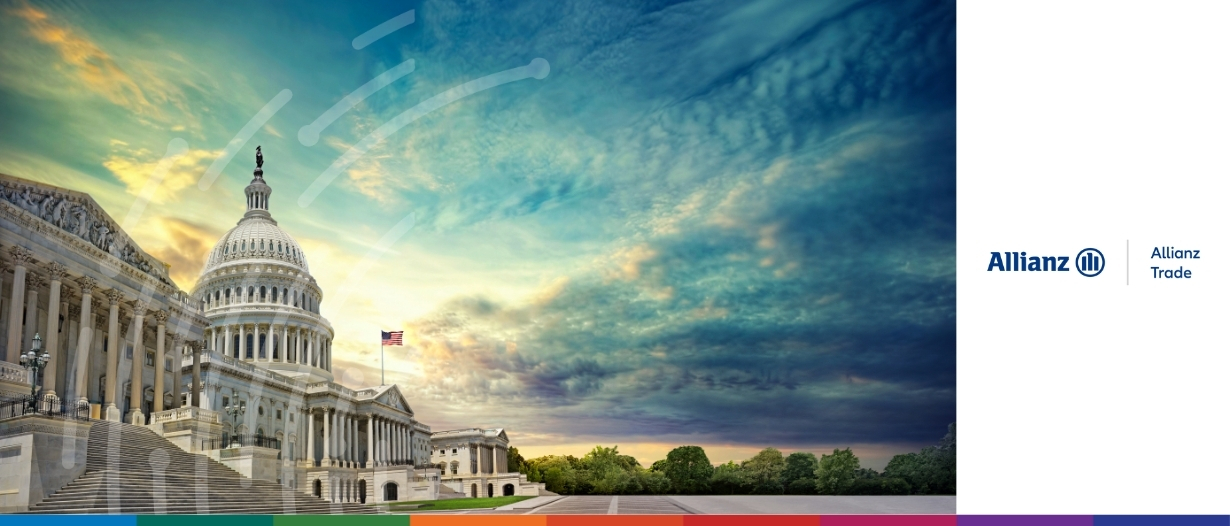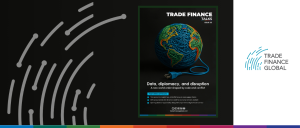Listen to this podcast on Spotify, Apple Podcasts, Podbean, Podtail, ListenNotes, TuneIn
- Trade-credit insurance is largely underutilised in the US.
- Political and economic uncertainty makes business riskier, and this has become normal.
- Fraud mechanisms and regulation develop simultaneously and reactively.
Grappling with new economic uncertainty, the trade credit insurance industry is in a transformative phase.
The US market, in particular, presents unique opportunities and obstacles. With its vast economy yet relatively low adoption of trade credit insurance, it remains a largely untapped yet potentially troublesome market wrought with economic fluctuations, sophisticated fraud schemes, and changing regulations.
To learn more about how the trade credit insurance industry is changing to meet these complex challenges, especially within the US, Trade Finance Global (TFG) spoke with James Daly, CEO of Allianz Trade – Americas.
Expansion and challenges of trade credit insurance in the US market
Despite being the largest economy in the world, the United States has historically been one of the least penetrated markets for trade credit insurance. As a comparison, in markets like Europe, the penetration rate of these instruments is around 15%, whereas in the US, it is a mere 2-3%.
Various factors contribute to this, including a general lack of awareness and businesses simply perceiving it as an unnecessary expense. Whatever the reason, it is clear that significant work remains to shift perceptions and introduce the benefits of trade credit insurance more widely.
The challenge is not only introducing the product to businesses but also communicating its value beyond risk transfer.
Daly said, “A lot of our time in the US is spent being an evangelist for the product, trying to help our future customers understand what the product is and what benefit it brings to them inside their organisation. It’s not just a risk transfer. It has so many other dimensions to it.”
For example, trade credit insurance can be a tool for growth, supporting businesses in accessing finance, enhancing balance sheet efficiency, and even managing new markets.
While penetration in the US remains low, there is optimism. Given the scale of its economy and the sheer number of businesses that could benefit from trade credit insurance, the significant upside of US market potential is evident.
To capitalise, insurers are investing heavily in education and outreach, engaging with industry networks, and building awareness. For the market to grow, insurers will need to continue these efforts and make the value of trade credit insurance more tangible to business leaders across the country.
Impact of economic uncertainty and political factors on business risk
The last half-decade has seen heightened economic uncertainty, with contributing factors including fluctuating interest rates, the ongoing effects of the pandemic, and political volatility, such as the US election cycle.
Economic uncertainty has, in fact, become the norm, creating a challenging environment for businesses.
Daly said, “Right now, that level of uncertainty is tremendous. The Fed rate was at the top level for a number of years, and that in itself has created a huge stress within many organisations because when they built their business models, historically, they were built on different debt models, and those debt models just get more and more expensive.”
This environment has heightened the need for trade credit insurance as businesses seek additional support in managing risks they may not fully understand or foresee.
Trade credit insurance helps by offering a partnership, allowing businesses to benefit from the insurer’s expertise in risk assessment and economic forecasting. Insurers can act as an additional set of eyes, providing insights and warnings that help companies make informed decisions during turbulent times.
Rising fraud and the evolution of fraud detection
As economic pressures increase, so too does the prevalence of fraud. The trade credit insurance industry has seen a notable rise in fraudulent activities, ranging from invoice fraud to more sophisticated identity-based schemes.
Daly said, “Fraud is not a new problem, but it does become more prevalent when times get tougher.”
Several different types of fraud exist—deliberate criminal activities, opportunistic fraud, and cyber-driven identity fraud—all of which have become more sophisticated with technological advancements.
One of the significant challenges today is the advent of artificial intelligence and deep fake technology, which makes identity verification increasingly difficult. Fraudsters are using these tools to create highly convincing false documentation and invoices.
The sophistication of these scams has reached the point where even seemingly authentic addresses or barcodes can be fake, designed to mislead suppliers into fulfilling fraudulent orders. To combat this changing threat, insurers are leveraging technology and vast data sets to proactively detect fraudulent activity.
Trade credit insurers like Allianz are using their comprehensive databases, which include millions of trading records, to validate transactions and identify red flags before they lead to significant losses.
Daly said, “We know people are trading with those companies. We’ve got those records. We can quickly see whether that invoice is valid, whether the company that is asking for payment is true, or if the person supplying it is who they’re saying they are.”
Insurers are also looking to foster greater collaboration within the industry, sharing insights and developing best practices for fraud prevention. The industry is increasingly recognising that tackling fraud will require a concerted, collective effort rather than isolated responses.
Regulatory developments and their influence on credit insurance demand
Regulatory changes are another driving force shaping trade credit insurance. In particular, the upcoming implementation of the US Basel Endgame, also known more widely as Basel 3.1, is set to impact the demand for credit insurance.
The regulatory landscape in Europe has already demonstrated how significant an influence these rules can have. European banks have increasingly turned to trade credit insurance to optimise their risk management and meet regulatory requirements, leading to accelerated adoption of the product across the continent.
In the United States, the regulatory environment has traditionally not been as favourable towards the use of trade credit insurance for capital relief. However, with the anticipated Basel changes, US banks are beginning to take notice.
Although they have historically been slower to adopt trade credit insurance for capital management purposes than their European counterparts, there is growing interest among stateside financial institutions. Banks are exploring the possibility of using credit insurance to reduce their capital requirements, especially as they prepare for the impending regulatory changes.
This shift presents an opportunity for the industry to further embed itself into the financial ecosystem. By providing banks with a means to optimise their capital allocation, trade credit insurers can enhance their role not just as risk mitigators but as strategic partners.
Daly said, “American banks are using trade credit, but not in the same way as we see the proliferation in Europe. But I do see that changing. You can see the banks are preparing for that Basel Endgame right now.”
This development could ultimately lead to wider adoption and integration of trade credit insurance within the broader financial services industry in the United States.
–
Faced with challenges such as low market penetration, economic uncertainty, sophisticated fraud, and regulatory changes, the trade credit insurance industry is adapting to meet the demands of an increasingly complex business landscape.
By positioning itself as more than just a risk transfer mechanism, trade credit insurance is transforming into a strategic tool that provides stability in uncertain times and helps businesses through both economic and operational challenges.
Ultimately, the evolution of trade credit insurance is not just about mitigating risk—it is about enabling businesses to thrive in a world where uncertainty is increasingly the only certainty.





























